Seasoned horseback riders know that choosing the right saddle is key if you want your ride to be smooth and enjoyable.
The right saddle ensures that both you and your horse are comfortable, thus guaranteeing you efficiency as you go about your activities.
But considering that there are many saddles for you to choose from in the Western saddle market, how do you pick the right one for your riding needs?
This article explores the ten common types of western saddles and their features.
As a result, you’ll gain valuable insights on how to choose a western saddle that matches your riding style and is suitable for the activity you will be using it for.
Let’s dive into the fascinating world of western saddles.
Table of Contents
1. All-Around Saddles
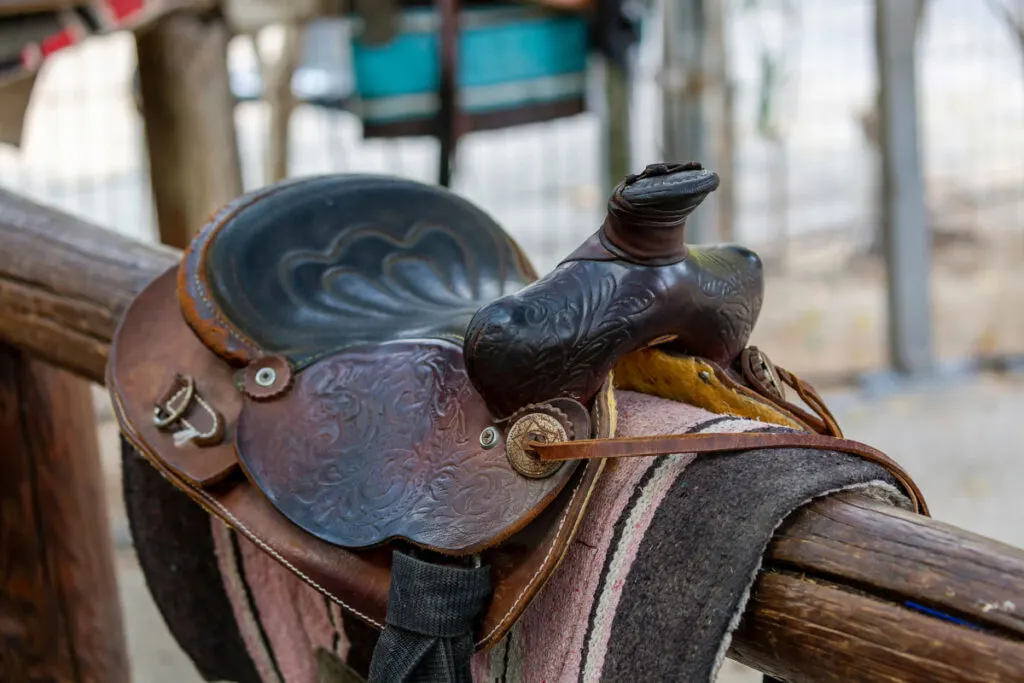
Features:
- Flatter seat
- Reinforced rigging
- Strong and stout horn
- Sturdy tree
- Close contact skirting
As the name suggests, the all-around saddle is a versatile Western saddle that can be used for practically any activity.
The saddle is purposefully designed to suit different horseback riding activities such as roping, ranching, trailing riding, barrel racing, and more.
All-around saddles have a strong horn to help rope and even drag cattle with them. To endure the strain of roping cows and calves, these saddles are built with a solid wooden tree.
In addition, these saddles usually have a flatter seat built with a nice pocket to keep the rider comfortable during speedy events.
All-around saddles also have reinforced rigging to ensure they can hold when roping or dragging. This type of saddle is popular with riders who perform multiple activities and events with their horse.
2. Ranch Saddles
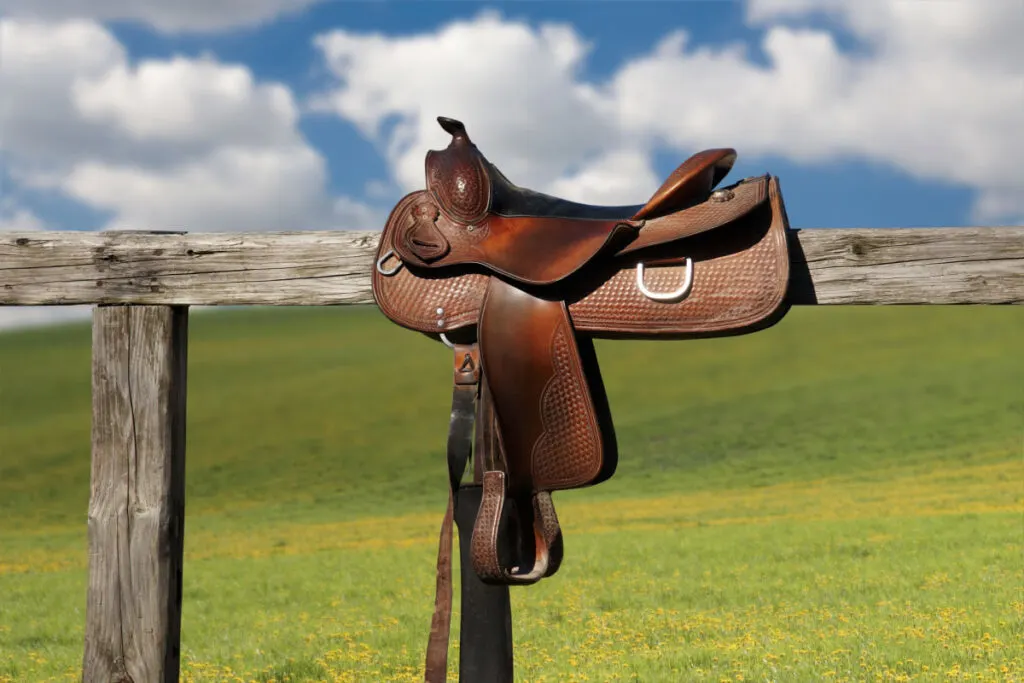
Features:
- Big and heavy
- Deep seat
- Strong tree
- Plate rigging
- Tall, hardy horn
This is another versatile Western saddle that can be used for most activities on a ranch.
The ranch saddle is big and heavy to ensure it can withstand rigorous work on the ranch.
This heavyweight saddle has a deep seat and high cantle for enhanced comfort and security when riding and working cattle. The horn on this saddle is tall and thick for roping and dragging.
When it comes to functionality, the ranch saddle outperforms many of the other Western saddles and that’s why it is popular with ranchers.
The saddle has multiple rings with strings attached so you can carry tools and other equipment you need on a regular working day.
The rings are made from durable materials, so they last long and serve you well as you engage in various ranching activities.
To hold the unit in place as you tackle strenuous ranch jobs, these saddles feature double rigging with both the front and flank cinch used for extra strength.
3. Barrel Racing Saddles
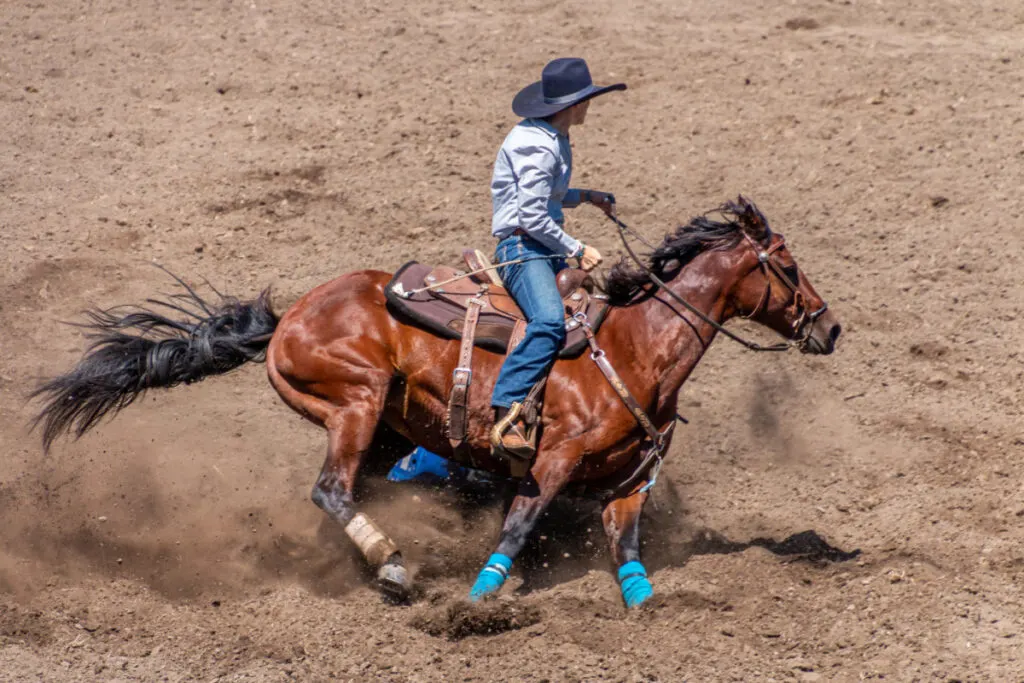
Features:
- Lightweight and compact
- Elevated cantle with a deeper pocket
- Tall, thin horn
- Shorter, rounded skirt
- In-skirt rigging
Barrel racing saddles or simply barrel saddles are used for an event known as barrel racing. This is a special rodeo event where a rider and a horse run around three barrels in a set pattern to achieve the fastest time.
Barrel racing saddles are small and lightweight to allow for seamless maneuverability. They also have a rough, deep seat to increase grip on the saddle and hold the rider in place during those quick, sharp turns.
Furthermore, barrel saddles have an elevated cantle to provide the rider with more protection as the horse goes around a turn.
And since the saddles are used in a competitive event, barrel racing saddles are designed to be lightweight and compact.
A lighter saddle doesn’t place too much weight on the horse, thus allowing it to move faster and finish ahead of other horses in the competition.
That said, the saddles have a shorter skirt that’s rounded most of the time. They also feature in-skirt rigging and have narrow stirrups.
The horn on a barrel saddle is tall and thin to hold on to. However, the horn is not strong enough and would break when you try to rope with it.
4. Roping Saddles
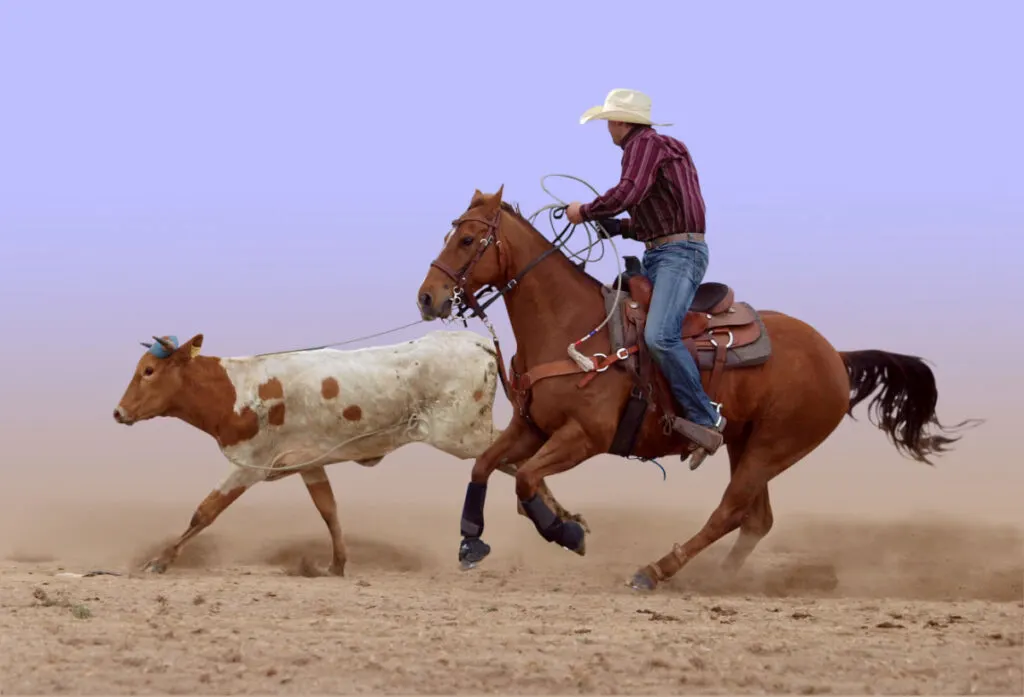
Features:
- Built on a sturdy tree
- Reinforced rigging
- Rough seat
- Lower cantle
- Deep stirrups
Designed to handle pressure, the roping saddle is a heavy-duty saddle built on a strong tree to ensure it can take in the force exerted on it when a rider ropes a cow to the saddle.
It also has reinforced rigging to prevent any breaks or rips.
Compared to other Western saddles, roping saddles are typically larger and heavier. Their horns are also well-anchored to withstand the force of a cow roped to the saddle.
Roping saddles have a nice pocket seat to keep the rider comfortable at all times. The surface of the seat is rough to prevent sliding as you go about your ranch work.
Additionally, the cantle is low to make it easy for the rider to dismount when working with cattle.
Other features of a roping saddle include deep stirrups that provide a solid base for the rider to brace themselves. They are also often built with a second skirt or a longer single skirt than other types of saddles.
Roping saddles are a hit with cowboys who use them when driving, branding, or loading cattle to trailers.
The design of these saddles gives the rider maximum freedom to move, thus allowing them to accomplish their ranch work with ease.
5. Cutting Saddles
Features:
- Flatter seat
- Lower cantle
- Square skirt
- Thin horn
- Slim stirrups
Are you planning to participate in a cutting event? Then you should get yourself a cutting saddle that will keep you balanced as the horse makes sudden moves.
Cutting saddles have a lower cantle and high pommel to provide greater flexibility when riding the horse during cutting events.
This allows the rider to stay out of the horse’s way and gives them space to complete the expected tasks.
The saddles also have a tall, thin horn that gives the rider a good grip when maneuvering and helps with balancing. The seat is flat with a slight rise at the pommel to give the rider maximum mobility.
Additionally, the lower cantle prevents the seat from digging into the rider’s back.
Lastly, cutting saddles usually feature a longer-than-average square skirt to provide additional coverage to the horse’s back. In some cases, a double skirt may be included in the saddle’s design.
6. Reining Saddles
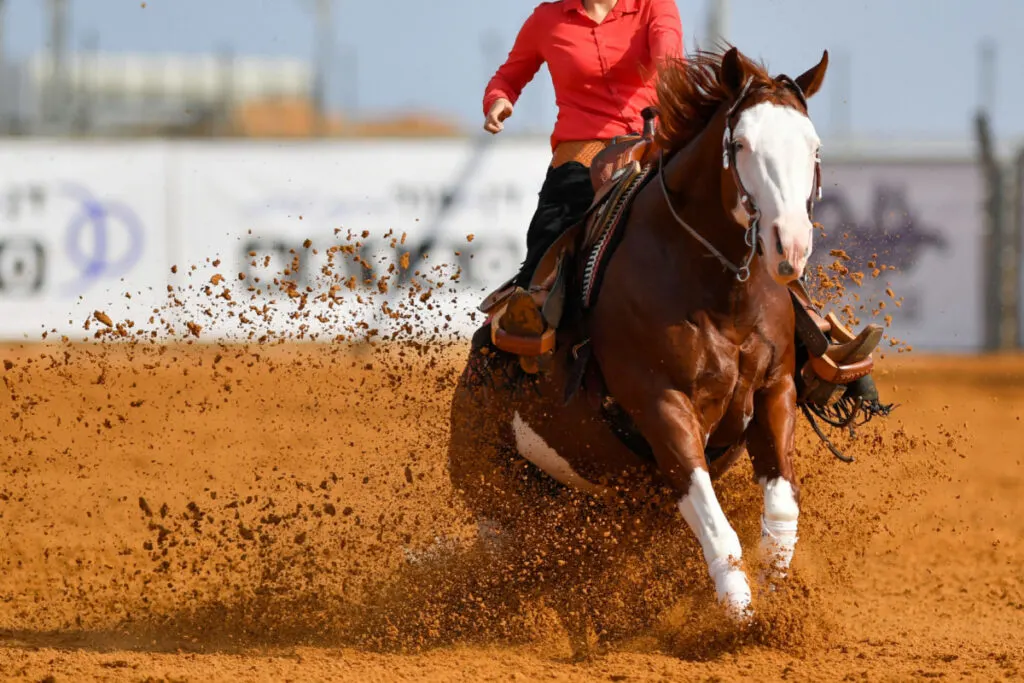
Features:
- Lower horn and pommel
- Flatter seat
- Bears show-type silver
- Low cantle
- Longer skirts
Reining saddles are used during a rodeo event known as reining. During this event, the rider must maintain complete control over the horse while making maneuvers such as sliding stops.
A good reining saddle helps the rider maximize their balance and agility during reining events.
Reining saddles also ensure close contact with the horse for seamless communication and transmission of cues, all of which are crucial for improving your scores during the event.
To facilitate the rider’s movement, these saddles have a lower pommel and horn. They also have a flat seat that supports quick hip movements.
The saddles also have longer, close-contact skirts to bring more attention to the rider’s legs. The skirts typically bear show-type silver to impress during reining competitions.
7. Show Saddles
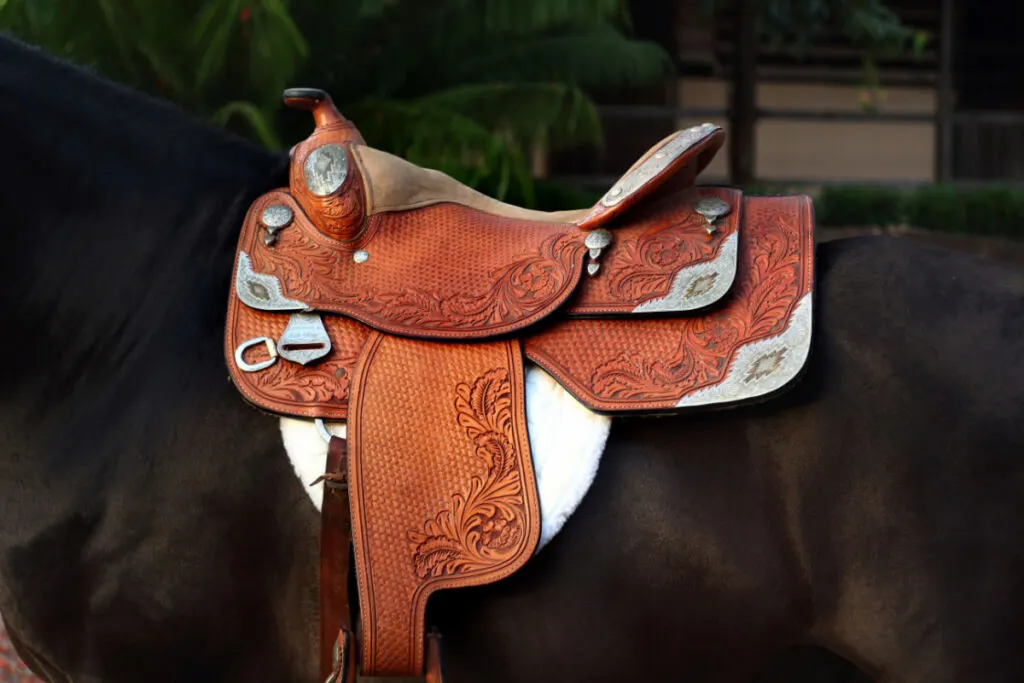
Features:
- Intricate tooling
- It is usually heavy
- Close contact skirts
- Low cantle
- Low horn
Show saddles are highly decorated saddles that are meant to look good in the exhibition ring. These saddles have detailed tooling and lots of silver that make them visually appealing.
They also have close-contact skirts to accentuate leg movements. Additionally, the skirts are long and typically have a layered design to draw attention to the saddle.
The seat on a show saddle is carefully balanced and has a functional pocket to put the rider in a good position when riding.
The cantle on these saddles is low and features deeper cuts than normal Western saddles to make it easy to mount and dismount the horse.
As the name suggests, show saddles are designed for competition and not everyday use. The horn and pommel on the saddle are low and cannot support strenuous activities.
The saddles are made with a generous amount of leather which makes them heavier than most saddles.
As a result, these saddles often come with a higher price tag, meaning that individuals seeking a show saddle should be prepared to pay top dollar.
8. Trail/Pleasure Saddles
Features:
- Available in different varieties
- Lightweight
- Designed with either high or low cantle
- Double rigging
- Wide stirrups
Trail saddles are a special type of Western saddle that are designed for comfort. They are lightweight with short, rounded skirts.
Pleasure saddles are meant to be comfortable for the rider and are typically designed with padded cushions to keep the rider in a good riding position.
Considering the saddles are used for long trail rides, they usually come with saddle strings or space to install them so you can carry everything you need during your excursion.
The saddles can have a lower cantle for extra comfort or an elevated one for more protection. Additionally, pleasure saddles also have shorter horns and pommels compared to other Western saddles.
However, most riders prefer their saddles without the horn to avoid getting hit when riding.
The stirrups on trail saddles are wide to give the rider a more comfortable base. Some saddles are also designed with double rigging to give the rider a better grip when traversing difficult terrains.
Due to their popularity, trail saddles come in different styles and colors. They can be designed with different tree, horn, skirt, and seat designs.
9. Endurance Saddles
Features:
- Small and lightweight
- Deep, comfortable seat
- Comes with multiple D-rings
- Lacks a horn
- Deep stirrups
Endurance saddles are tough western saddles that can withstand the rigors of long-distance riding.
The saddles are made of high-quality leather and fitted with appropriate features to make them comfortable for the rider and horse.
The saddle is lightweight to ensure the horse doesn’t carry too much weight when riding. The seat is also deep to provide additional comfort during those long rides.
To help you carry everything you need during your trip, endurance saddles are fitted with several D-rings that you can use to attach bags, pouches, and other essential items to the saddle for convenient storage as you ride.
Unlike most Western saddles, endurance saddles don’t have a horn. They are also designed with short, rounded skirts and deep stirrups to give you more support when maneuvering rough and steep terrains.
10. Mounted Shooting Saddles
Features:
- Forward tilted swell
- Low horn
- Deep seat
- Lightweight
- Free-swinging fenders
Another popular western saddle is the mounted shooting saddle.
These saddles are quite similar to barrel racing saddles, with their lightweight design and close-contact skirt that emphasizes the rider’s leg movements.
Mounted shooting saddles have a low horn and tilted swell to make it easy for the rider to switch guns during a challenge.
If the horn were tall and the swell straight, riders would constantly hit the horn when switching guns, resulting in gradual damage over time.
The saddles come with free-swinging fenders to give the shooter more mobility.
They also have a deep seat to keep the shooter comfortable in the saddle and a high cantle for extra protection when riding.
Final Thoughts
There you have it. Those are the different western saddles you can get for your riding needs. Remember, your choice will depend on the task/activity ahead and the type of riding you are planning to do.
By understanding the benefits and features of each saddle type, you can make an informed decision and make the most of your Western saddle when riding.
Resources
- https://saddleupcolorado.net/blog/the-different-types-of-western-saddles-and-their-purpose-/
- https://evolutiontack.ca/blogs/tack-tip-tuesday/different-types-of-western-saddles
- https://horseracingsense.com/types-of-western-saddles/
- https://www.horse.com/content/western-tack/types-of-western-saddles/
- https://en.wikipedia.org/wiki/Western_saddle
- https://www.horsesaddleshop.com/differences-between-saddles.html
- https://animalofthings.com/different-types-of-western-saddles/

